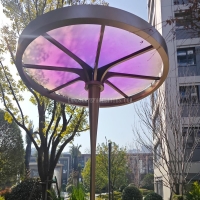Welcome to the website for landscape facilities products and knowledge.
How does the texture of a landscape bar counter surface impact slip resistance in wet conditions?
The integration of outdoor living spaces has made landscape bar counters a central feature for entertainment. However, their exposure to weather elements, particularly rain and spills, raises significant safety concerns regarding slip resistance. The texture of the counter's surface is the primary determinant of its safety in these wet conditions, influencing both traction and water displacement.
A smooth, polished surface, while aesthetically pleasing and easy to clean, becomes dangerously slick when wet. Water forms a thin film between the sole of a shoe or a bare foot and the counter surface, drastically reducing the coefficient of friction. This creates a high risk of slips and falls, especially in environments where people are moving around with drinks. In contrast, a deliberately textured surface acts as a series of microscopic obstacles. These imperfections, whether from a brushed finish, aggregate exposure, or a patterned imprint, break up the continuous water film. They provide points of direct contact for footwear, thereby increasing grip. The effectiveness of this texture is measured by its coefficient of friction (COF), with a higher dry and wet COF indicating greater slip resistance.
The method of texturing varies by material. For natural stone like granite or bluestone, a flamed or bush-hammered finish creates a rough, pitted surface that excels at draining water and providing grip. Concrete counters offer immense flexibility; textures can be achieved through light brushing before curing, exposing aggregate, or using textured form liners. Tile surfaces rely on their individual tile's rating, with a high COF rating (generally above 0.60 for wet areas) being crucial, and the grout lines also adding valuable traction. Even synthetic composites and woods can be manufactured or treated with non-slip coatings and grooves.
Beyond the immediate texture, other factors contribute to overall safety. The slope, or pitch, of the countertop is critical. A slight slope of 1-2% encourages water to run off the surface rather than pool, keeping the primary walking and leaning areas drier. The choice of material itself also matters; some porous materials can absorb water, potentially becoming slippery or harboring mold, which can also create a slick surface.
Ultimately, selecting the right texture for a landscape bar counter is a vital design decision that balances aesthetics with paramount safety. A rough, textured finish may require slightly more effort to clean but provides the necessary traction to prevent accidents, ensuring the outdoor bar remains a place of enjoyment, not injury. Consulting with a designer and understanding the wet COF ratings of materials is essential for any homeowner creating a safe and functional outdoor entertaining space.
Related search:

Recommendation
Metal frame with gradient color acrylic combined with high-end shading landscape facilities